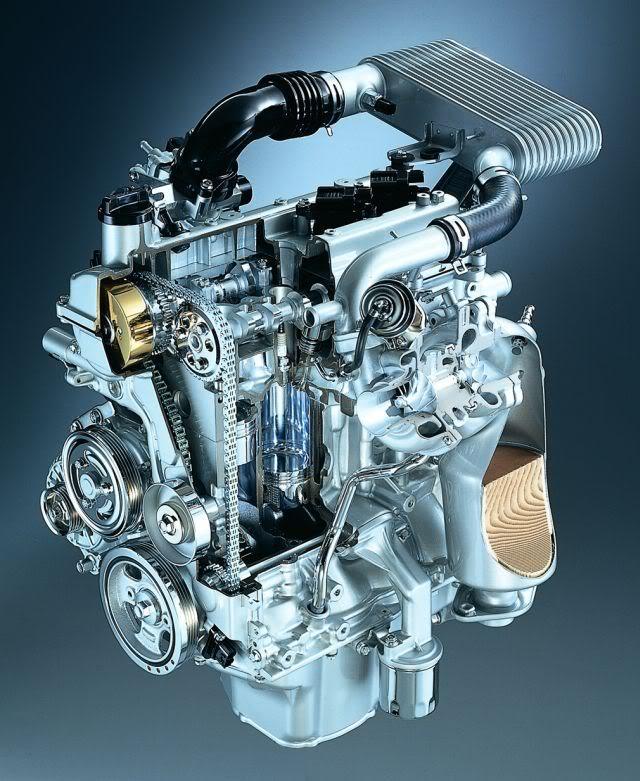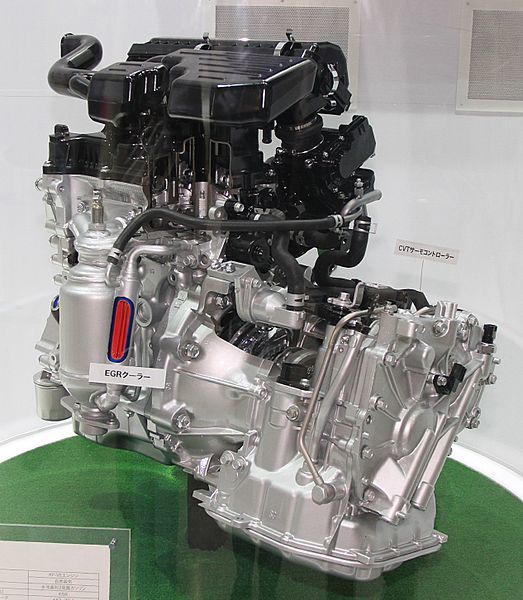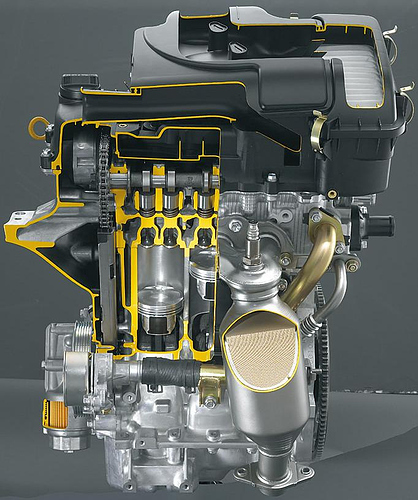Daihatsu K-series Engines
Please note that on a mobile device you will not see the entire tables listed in this thread
The Daihatsu K-Series engine is a compact four cylinder, internal combustion piston engine. Designed by Daihatsu with its subsidiary of Toyota. Some Toyota models received this engine in Japan (Duet, Cami, Sparky, Passo, BB).
The Daihastu K-Series engines are fitted to many models and have different configurations and power outputs. Locally delivered to Australia there was the K3-VE and K3-VE2 variants. These were fitted to Daihatsu Sirion GTVi, Daihatsu Terios, Daihatsu YRV and Daihatsu M301 (Sirion).
The K3-VE/2 engine runs 16 valve twincam head, double row timing chain and features DVVT (Dynamic Variable Valve Timing) with 10:1(K3-VE) or 11:1(K3-VE2) static compression.
There is also a series of engines that were produced for the Indonesian market only, these were named a K3-DE and produced 66 kw @ 6000rpm and did not feature DVVT.
Available to the Japanese, European and Russian market was the K3-VET which was a Turbocharged version of the K3-VE/2 running a RHF4 turbo and was found in the Daihatsu Terios and YRV Turbo on the Japanees market, in the European and Russian market it was only available in the YRV turbo (in Germany this was called the YRV GTti as a tribute to the charade GTti).
(K3-VE2)
(K3-VET)
(KF-VE)
(1KR-FE)
K3-Series (1297cc)
All K3 engines feature EFI and are of a 16V DOHC Configuration and all blocks are of cast iron and feature a bore and stoke of 72.0 x 79.7(Bore x Stroke).
Engine Variants (K3)
| Varient | Induction | KW | @RPM | NM | @RPM | Comp | DVVT | Chassis |
|---|---|---|---|---|---|---|---|---|
| K3-DE | NA | 66 | 6000 | 114 | 4400 | 10 | No | Xenia (Indonesian), GrandMax MB (Indonesian) |
| K3-VE | NA | 68 | 6000 | 123 | 4400 | 10 | Yes | Terios, YRV, M301(Sirion) |
| K3-VE2 | NA | 75(AU) 81(JP) | 7000 | 126 | 4400 | 11 | Yes | M101 Sirion GTVi |
| K3-VET | IC Turbo | 103 | 6400 | 177 | 3200 | 8.5 | Yes | Terios, YRV Turbo |
| KJ-VET (936cc) | IC Turbo | 98 | 7200 | 133 | 3600 | 8.3 | Yes | Storia X4 |
ECU Models
| Varient | ECU Number | Chassis |
|---|---|---|
| K3-DE | ? | ? |
| K3-VE | ? | ? |
| K3-VE2 | ? | ? |
| K3-VET | P57 - 89560-97H11 | YRV Turbo TYPE R |
| K3-VET | L38 - 89560-97B03 | YRV Turbo |
| KJ-VET | ? | Storia X4 |
| Varient | Oil Filter | Spark Plug | Air Filter | Fuel Filter | Spark Gap | Timing |
|---|---|---|---|---|---|---|
| K3-DE | ? | ? | ? | ? | ? | ? |
| K3-VE2 | Z443 | NGK - BKR6EY-11 | ? | ? | 1.0 -1.1mm | 6 degrees BTDC [+/- 2 degrees] @ Idle |
| K3-VE2 | Z443 | NGK - BKUR6ETB-10 | ? | ? | 0.9-1.0mm | 6 degrees BTDC [+/- 2 degrees] @ Idle |
| K3-VE2 | Z443 | DENSO K20R-U11 | ? | ? | 1.0-1.1mm | 6 degrees BTDC [+/- 2 degrees] @ Idle |
| K3-VE2 | Z443 | DENSO K20BR-S10 | ? | ? | 0.9-1.0mm | 6 degrees BTDC [+/- 2 degrees] @ Idle |
| K3-VE | Z443 | NGK - BKR6EY-11 | ? | ? | 1.0 -1.1mm | 6 degrees BTDC [+/- 2 degrees] @ Idle |
| K3-VE | Z443 | NGK - BKUR6ETB-10 | ? | ? | 0.9-1.0mm | 6 degrees BTDC [+/- 2 degrees] @ Idle |
| K3-VE | Z443 | DENSO K20R-U11 | ? | ? | 1.0-1.1mm | 6 degrees BTDC [+/- 2 degrees] @ Idle |
| K3-VE | Z443 | DENSO K20BR-S10 | ? | ? | 0.9-1.0mm | 6 degrees BTDC [+/- 2 degrees] @ Idle |
| K3-VET | Z443 | DENSO - PK20PTR-S9 | ? | ? | 0.8-0.9mm | 6 degrees BTDC [+/- 2 degrees] @ Idle |
| K3-VET | Z443 | NGK - BKUR6EKPA | ? | ? | 0.8-0.9mm | 6 degrees BTDC [+/- 2 degrees] @ Idle |
| KJ-VET | ? | ? | ? | ? | ? | ? |
KF Engine (658cc)
The KF Engine was fitted to the Japanese market Daihatsu Copen from 2014 onward.
- 658cc 3 cylinder 12-valve DOHC intercooled turbocharged
- Compression ratio — 9.5
- Power — 47 kW (63 hp) at 6400 rpm
- Torque — 92 N·m (68 lb·ft) at 3200 rpm
##Daihastu KR-Series Engines (Diesel)
The Toyota KR engine family is a straight-3 piston engine series, designed by Daihatsu, which is a subsidiary of Toyota. The 1KR series uses aluminium engine blocks and chain driven DOHC cylinder heads. It uses multi-point fuel injection, and has 4 valves per cylinder with VVT-i whilst some of the series do not have it.The engine is also exceptionally light with a 69 kg weight with all ancillaries. This is due to the nature of the applications and weight of city cars.
1KR-FE
1KR-FE used in Daihatsu Sirion, Toyota Aygo, Citroën C1 and Peugeot 107
The 1KR-FE is a 1.0 L (996 cc) version built in Japan and Poland. Bore is 71 mm and stroke is 84 mm, with a compression ratio of 10.5:1. Output is 67 PS (49 kW) at 6000 rpm with 91 N·m (67 lb·ft) of torque at 4800 rpm or 71 PS (52 kW) at 6000 rpm with 94 N·m (69 lb·ft) of torque at 3600 rpm. When originally on sale it met European emission standard EU4 requirements and had CO2 levels of 109 g/km, but current applications meet European emission standard EU5 and can have CO2 levels as low as 99 g/km.This engine has been given the 2007, 2008, 2009 and 2010 International Engine of the Year awards in the sub-1.0 liter category.
The engine was also adapted to meet European emission standard EU6 and can have CO2 levels as low as 88/89 g/km in Toyota Aygo or Citroen C1/Peugeot 108 since 2014 in NEDC.
Applications:
Toyota Passo/Daihatsu Boon
Toyota Aygo/Citroën C1/Peugeot 107 (2005-2014)
Toyota Vitz/Yaris (2005–)
Toyota Belta (2006-2012)
Toyota iQ
Daihatsu Cuore L276 (09.2007-)
Daihatsu Sirion M300
Subaru Justy (2008-)
Daihatsu Ayla/Toyota Agya/Wigo (2013-)
Toyota Aygo/Citroën C1/Peugeot 108 (2014-)
Toyota Tank/Toyota Roomy/Daihatsu Thor (2016-)
1KR-DE
The 1KR-DE is the non-VVT-i variant of the 1KR engine. It produces less power and torque than 1KR-FE. Output is 65 PS (48 kW) at 6000rpm and 85 N·m (63 lb·ft) of torque at 3600rpm. Bore is 71 mm and stroke is 84 mm, while the engine displacement is 1.0 L (998 cc).
The 1KR-DE was specially designed for the Indonesian LCGC (Low Cost Green Car) market to reduce cost. The engine cylinder head cover is made from plastic-resin instead of aluminium to save 10 kg of weight. The exhaust manifold is integrated to the cylinder head together with the catalytic converter and oxygen sensor to save even more weight.
Applications:
Daihatsu Ayla (2012-)
Toyota Agya (2012-2017)
Daihatsu Hi-Max / Hijet tenth generation (2016-)
1KR-DE2
The 1KR-DE2 is the more powerful variant of the 1KR-DE engine which is redesigned by Perodua. It produces 66 PS (49 kW) at 6000rpm and 90 N·m (66 lb·ft) of torque at 3600rpm. Like the 1KR-DE, bore and stroke are at 71mm and 84mm respectively, and engine displacement remains at (998 cc) The 1KR-DE2 achieves Euro IV emission standard and it is very fuel efficient due to the ECO Mode, but still lacks VVT-i when compared to 1KR-FE. The compression ratio for this engine is 11:1.
Application:
Perodua Axia (2014-2017)
1KR-VE
The “1KR-VE” is a more powerful variant made by Perodua specifically improved version from the 1KR-DE2 which is made for the newest edition in the Perodua family. It was specifically made for the 1.0cc variant for Perodua’s first solely in-house manufactured car which is the Perodua Bezza. It is a modified and refined version of the 1KR-DE2 engine from the Perodua Axia. The new 1KR-VE engine produces 67 hp at 6,000 rpm and 91 Nm at 4,400 rpm, offering a mild 1 hp and 1 Nm increase over the Axia’s 1KR-DE2 plant. Perodua claims ECE fuel consumption figures of 22.8 km/l for the manual variant and 21.3 km/l with the automatic, both exhibiting a 1.2 km/l improvement over the old 1KR-DE2. The new 1KR-VE engine now features variable-valve timing with intelligence (VVT-i) on the intake valves. Several minor changes and refinements were also introduced for increased fuel efficiency and more linear power delivery. Notable changes include a higher 11.5:1 compression ratio, a high-tumble intake port, a longer intake manifold, micro fuel spray injection and low-friction valve lifters.
Application:
Daihatsu Sigra (Non ECO Mode) (2016-)
Perodua Bezza (2016-)
Toyota Agya/Perodua Axia (2017-)
Original K3 Source - https://ja.wikipedia.org/wiki/ダイハツ・K3型エンジン
Original KF-source - https://en.wikipedia.org/wiki/Daihatsu_Copen





